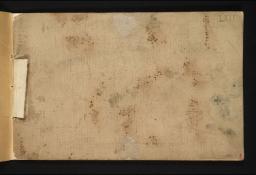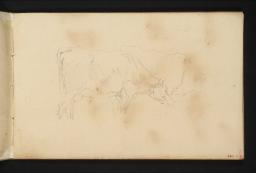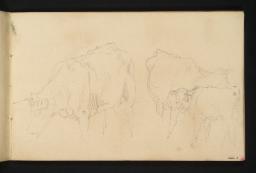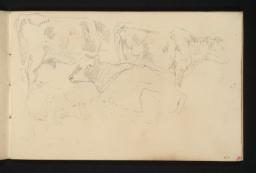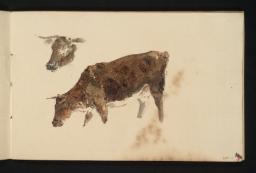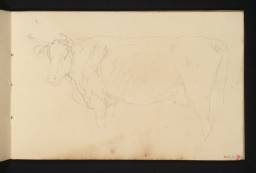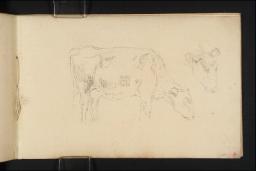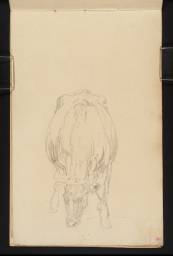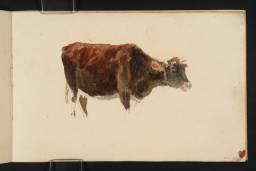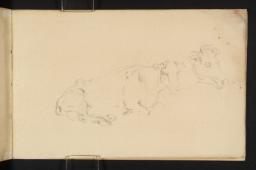Turner Bequest LXII 1–13a
Sketchbook lacking covers, bound in modern buff paper wrapper
14 leaves of cream laid writing paper; 117 x 184 mm; watermark ‘king’ with fleur-de-lys emblem (trimmed)
Made by John Larking, of Upper Paper Mill, East Malling, Kent
Inscribed by Turner in ink ‘106’ on parchment label tipped in on folio 1 recto (D03721)
Numbered 220 as part of the Turner Schedule in 1854, and endorsed by the Executors of the Turner Bequest on the verso of folio 1 (D03721)
14 leaves of cream laid writing paper; 117 x 184 mm; watermark ‘king’ with fleur-de-lys emblem (trimmed)
Made by John Larking, of Upper Paper Mill, East Malling, Kent
Inscribed by Turner in ink ‘106’ on parchment label tipped in on folio 1 recto (D03721)
Numbered 220 as part of the Turner Schedule in 1854, and endorsed by the Executors of the Turner Bequest on the verso of folio 1 (D03721)
Accepted by the nation as part of the Turner Bequest 1856
References
The collection of studies of cows that this sketchbook contains is consistent with Turner’s occasional habit of devoting a separate book to staffage; see for instance the 1801 Scotch Figures sketchbook (Tate; Turner Bequest LIX) and the 1802 Swiss Figures sketchbook (Tate; Turner Bequest LXXVIII). In this instance, Turner pays homage to a staple of the Picturesque as defined by the Reverend William Gilpin (1724–1804), the foreground group of three or five (but not two or four) cows, odd numbers of cows and sheep always being preferable.1
Many of Turner’s watercolours of this early period, and indeed much later, incorporate cows drawn on a large scale; examples are St Agatha’s Abbey, Easby, Yorkshire (Whitworth Art Gallery, Manchester),2 St Donat’s Castle, South Wales: Summer Evening of 1801 (private collection)3 and Edinburgh, from Caulton-hill, exhibited in 1804 (Tate D03639; Turner Bequest LX H).4 He may have continued to refer to the book some years later; see for instance the painting The Quiet Ruin, Cattle in Water; A Sketch, Evening (Tate N00487),5 possibly shown in Turner’s gallery in 1809. Specific links have been proposed between another oil painting of about 1809 with the drawings on folios 10 recto and 13 recto (D03731, D03734). But Turner may have made these studies simply to acquaint himself more fully with the anatomy and general demeanour of cows.
Other studies of cows are scattered through the Turner Bequest; see for example the Brocklesby Mausoleum sketchbook (Tate D05164; Turner Bequest LXXXIII 6) and the Helmsley sketchbook (Tate D02527; Turner Bequest LIII 39). A study of cows in the possession of the Reverend W. Kingsley was referred to by John Ruskin in a diary entry summarising his intentions for an unrealised section on ‘Water Beauty’ for Modern Painters.6 Finberg gives c.1801 as the date of this book,7 which appears to be confirmed on technical grounds as the earliest possible date (see the technical notes below).
See Gilpin’s Observations Relative Chiefly to Picturesque Beauty Made in the Year 1772, on Several Parts of England, Particularly the Mountains, and Lakes of Cumberland, and Westmoreland, London 1786, vol.II, section XXXI, p.258; compare Jane Austen’s Pride and Prejudice (1813), chapter X: ‘You are charmingly group’d, and appear to uncommon advantage. The picturesque would be spoilt by admitting a fourth.’
Martin Butlin and Evelyn Joll, The Paintings of J.M.W. Turner, revised ed., New Haven and London 1984, pp.62–3 no.83, pl.93.
Technical notes
How to cite
Andrew Wilton, ‘Cows sketchbook c.1801’, sketchbook, May 2013, revised by Matthew Imms, April 2016, in David Blayney Brown (ed.), J.M.W. Turner: Sketchbooks, Drawings and Watercolours, Tate Research Publication, April 2016, https://www

